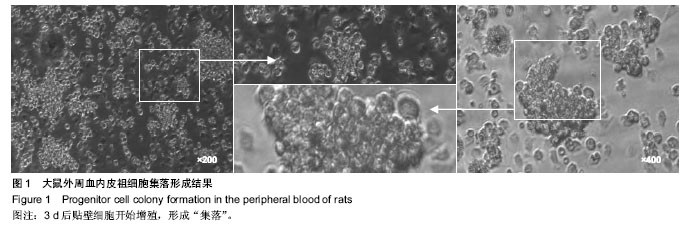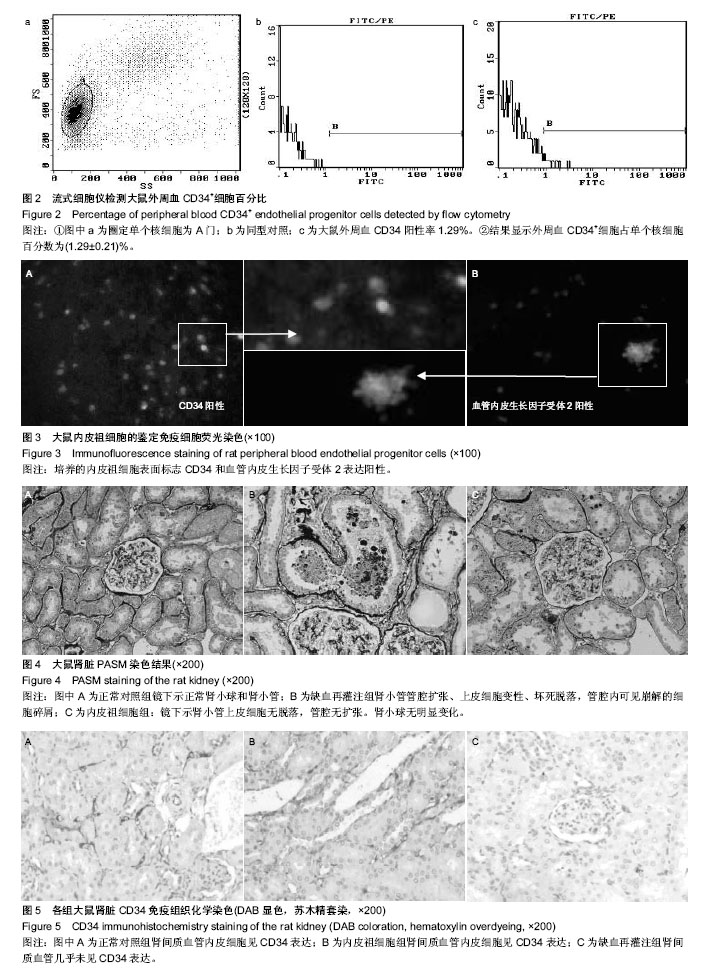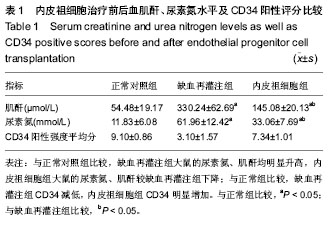| [1] Lameire N,Van Biesen W,Vanholder R.Acute renal failure. Lancet.2005; 365(9457):417-430.
[2] Asahara T,Murohara T,Sullivan A,et al.Isolation of putative progenitor endothelial cells for angiogenesis. Science.1997; 275(14): 964-967.
[3] Hur J, Yoon CH, Kim HS,et al.Characterization of two types of endothelial progenitor cells and their different contributions to neovasculogenesis. Arterioscler Thromb Vasc Biol.2004; 24(2): 288-293.
[4] Dimmeler S,Aicher A,Vasa M, et al. HMG-CoA reductase inhibitors (statins) increase endothelial progenitor cells via the PI3-kinase/Akt pathway.J Clin Invest.2001;108:391-397.
[5] Lin F, Cordes K, Li L, et al. Hematopoietic stem cells contribute to the regeneration of renal tubules after renal ischemia-reperfusion injury in mice. J Am Soc Nepbrol.2003; 14(5):1188-1199.
[6] Reinders ME, Rabelink TJ, Briscoe DM. Angiogenesis and endothelial cell repair in renal disease and allograft rejection. J Am Soc Nephrol.2006;17(4):932-942.
[7] Brodsky SV, Yamamoto T, Tada T,et al. Endothelial dysfunction in ischemic acute renal failure: rescue by transplanted endothelial cells.Am J Physiol Renal Physiol. 2002;282(6):F1140-9.
[8] Basile DP. The endothelial cell in ischemic acute kidney injury: implications for acute and chronic function. Kidney Int.2007; 72 (2):151-156.
[9] Raij L, Azar S, Keane W. Mesangial immune injury,hypertension and progressive glomerular damage in Dahl rats. Kidney Int.1984;26(2):137-143.
[10] Masuda H, Iwasaki H, Kawamoto A, et al.Development of serum-free quality and quantity control culture of colony-forming endothelial progenitor cell for vasculogenesis. Stem Cells Transl Med.2012;1(2):160-171.
[11] Rafii S, Lyden D. Therapeutic stem and progenitor cell transplantation for organ vascularization and regeneration. Nat Med.2003;9(6):702-712.
[12] Gulati R, Simari RD.Cell therapy for angiogenesis: embracing diversity. Circulation.2005;112(11):1522-1524.
[13] Patschan D, Krupincza K, Patschan S, et al. Dynamics of mobilization and homing of endothelial progenitor cells after acute renal ischemia: modulation by ischemic preconditioning. Am J Physiol Renal Physiol.2006;291(1):F176-85.
[14] Rookmaaker MB, Smits AM, Tolboom H, et al. Bone-marrow-derived cells contribute to glomerular endothelial repair in experimental glomerulonephritis.Am J Pathol.2003;163(2):553-562.
[15] Uchimura H, Marumo T, Takase O, et al.Intrarenal injection of bone marrow-derived angiogenic cells reduces endothelial injury and mesangial cell activation in experimental glomerulonephritis. J Am Soc Nephrol.2005;16(4):997-1004.
[16] Ikarashi K, Li B, Suwa M, et al. Bone marrow cells contribute to regeneration of damaged glomerular endothelial cells. Kidney Int.2005;67(5):1925-1933.
[17] Li XQ, Meng QY, Wu HR. Effects of bone marrow-derived endothelial progenitor cell transplantation on vein microenvironment in a rat model of chronic thrombosis. Chin Med J.2007;120(24):2245-2249.
[18] 李崇剑,高润霖,杨跃进,等.猪心脏缺血再灌注损伤区自体骨髓单个核细胞和外周血内皮祖细胞移植后细胞分化探讨[J].中华心血管病杂志,2007,35(4):350-353.
[19] 赵洪雯,余荣杰,刘宏,等.内皮祖细胞移植对延缓大鼠进展性局灶节段性肾小球硬化的实验研究[J].第三军医大学学报,2007, 29(21):2044-2048.
[20] 陈波,薄成佳,贾瑞鹏,等.内皮祖细胞在早期急性肾缺血再灌注损伤中的抗凋亡作用观察[J].东南大学学报,2012,31(5):581-585.
[21] Liang CJ, Shen WC, Chang FB,et al.Endothelial progenitor cells derived from Wharton's jelly of human umbilical cord attenuate ischemic acute kidney injury by increasing vascularization and decreasing apoptosis, inflammation, and fibrosis.Cell Transplant. 2014 . [Epub ahead of print]
[22] Chen B, Bo CJ, Jia RP, et al.The renoprotective effect of bone marrow-derived endothelial progenitor cell transplantation on acute ischemia-reperfusion injury in rats.Transplant Proc. 2013; 45(5):2034-2039.
[23] Bo CJ, Chen B, Jia RP,et al.Effects of ischemic preconditioning in the late phase on homing of endothelial progenitor cells in renal ischemia/reperfusion injury. Transplant Proc. 2013;45(2):511-516.
[24] Liu H, Wu R, Jia RP, et al.Ischemic preconditioning increases endothelial progenitor cell number to attenuate partial nephrectomy-induced ischemia/reperfusion injury.PLoS One. 2013;8(1):e55389.
[25] Cantaluppi V, Gatti S, Medica D,et al. Microvesicles derived from endothelial progenitor cells protect the kidney from ischemia-reperfusion injury by microRNA-dependent reprogramming of resident renal cells.Kidney Int.2012; 82(4): 412-427..
[26] Patschan D, Hildebrandt A, Rinneburger J, et al.The hormone melatonin stimulates renoprotective effects of "early outgrowth" endothelial progenitor cells in acute ischemic kidney injury.Am J Physiol Renal Physiol. 2012;302(10): F1305-12.
[27] Patschan D, Patschan S, Müller GA.Endothelial progenitor cells in acute ischemic kidney injury: strategies for increasing the cells' renoprotective competence.Int J Nephrol.2011; 2011: 828369.
[28] Kwon O, Miller S, Li N,et al.Bone marrow-derived endothelial progenitor cells and endothelial cells may contribute to endothelial repair in the kidney immediately after ischemia-reperfusion.J Histochem Cytochem.2010;58(8): 687-694.
[29] Choi HY, Moon SJ, Ratliff BB,et al.Microparticles from kidney-derived mesenchymal stem cells act as carriers of proangiogenic signals and contribute to recovery from acute kidney injury.PLoS One. 2014;9(2):e87853.
[30] Yasuda K, Vasko R, Hayek P, et al.Functional consequences of inhibiting exocytosis of Weibel-Palade bodies in acute renal ischemia.Am J Physiol Renal Physiol.2012;302(6):F713-21.
[31] 刘昊,吴然,贾瑞鹏,等.缺血预适应对肾脏缺血再灌注损伤后内皮祖细胞归巢动力学的影响[J].中华肾脏病杂志,2013,29(3): 199-203.
[32] 李和文,王嘉锋,于光.MicroRNA在肾脏缺血再灌注损伤中的研究进展[J].第二军医大学学报,2013,34(12):1365-1370.
[33] 余毅,谢福安,王琰.内皮祖细胞骨移植在缺血再灌注肾损伤中的促血管新生作用[J]. 世界临床药物,2009,30(2):72-75.
[34] 马慧珍.粒细胞集落刺激因子治疗急性肾缺血再灌注损伤的研究[J].郑州:郑州大学,2010. |


